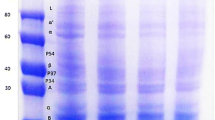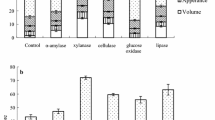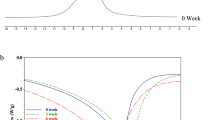Abstract
Frozen dough made using flour of higher protein content (9.5–11 %) had better resistance to freezing damage than those made using flour of lower protein content and resulted in steamed bread whose specific volume, form ratio and texture were closer to those of bread made from fresh dough. The effects of flour protein content and freezing conditions (freezing air temperature and air speed) on dough and steamed bread quality were investigated in this study. Compared to nonfrozen control, the freezing process caused a deterioration to gluten network as well as a decrease in yeast activity, which resulted in lower maximum dough height and less total gas production, leading to steamed bread of lower specific volume and form ratios, and increased hardness. Faster freezing rates resulted in dough with higher extensibility and a less damaged dough microstructure but led to a decrease in total gas production as yeast activity was compromised. The extreme freezing conditions of −20 °C and air speed of 0 m/s and −40 °C and air speed of 6 m/s had the poorest dough and steamed bread quality. Samples frozen at −30 °C had better form ratio of steamed bread than those frozen at −20 °C and −40 °C, while those frozen at −40 °C had the lowest specific volume. A moderate air speed of 3 m/s resulted in higher volume of total gas production and dough height, as well as better steamed bread texture.






Similar content being viewed by others

References
Abbasi, H., Ardabili, S. M. S., Emam-Djomeh, Z., Mohammadifar, M. A., Zekri, M., & Aghagholizadeh, R. (2012). Prediction of extensograph properties of wheat-flour dough: artificial neural networks and a genetic algorithm approach. Journal of Texture Studies, 43(4), 326–337.
Ananingsih, V. K., Gao, J., & Zhou, W. (2013). Impact of green tea extract and fungal alpha-amylase on dough proofing and steaming. Food and Bioprocess Technology, 6(12), 3400–3411.
Baguena, R., Soriano, M. D., Martinezanaya, M. A., & Debarber, C. B. (1991). Viability and performance of pure yeast strains in frozen wheat dough. Journal of Food Science, 56(6), 1690–1694.
Bao YR & Wang XL (2011). Research on water’s influences on the quality of frozen dough. In: Dan Y (ed) 2011 International Conference on Environment Science and Biotechnology. Procedia Environmental Sciences. Amsterdam: Elsevier Science Bv, pp 313-318.
Bao YR, Wang XL & Ren SC (2012). Emulsifier’s influence on the quality of frozen dough. In: Wang D (ed) Materials for environmental protection and energy application. Advanced Materials Research. Kuala Lumpur: Trans Tech Publications Ltd, pp 423-429.
Bhattacharya, M., Langstaff, T. M., & Berzonsky, W. A. (2003). Effect of frozen storage and freeze–thaw cycles on the rheological and baking properties of frozen doughs. Food Research International, 36(4), 365–372.
Dobraszczyk, B. J., & Morgenstern, M. (2003). Rheology and the breadmaking process. Journal of Cereal Science, 38(3), 229–245.
Faegestad, E. M., Molteberg, E. L., & Magnus, E. M. (2000). Interrelationships of protein composition, protein level, baking process and the characteristics of hearth bread and pan bread. Journal of Cereal Science, 31(3), 309–320.
Goesaert, H., Brijs, K., Veraverbeke, W. S., Courtin, C. M., Gebruers, K., & Delcour, J. A. (2005). Wheat flour constituents: how they impact bread quality, and how to impact their functionality. Trends in Food Science & Technology, 16(1-3), 12–30.
Havet, M., Mankai, M., & Le Bail, A. (2000). Influence of the freezing condition on the baking performances of French frozen dough. Journal of Food Engineering, 45(3), 139–145.
Hou, G. G., & Popper, L. (2006). Chinese steamed bread. In L. Popper (Ed.), Future of Flour: A compendium of flour improvement (pp. 309–318). Germany: AgriMedia.
Huang, S. D., Yun, S. H., Quail, K., & Moss, R. (1996). Establishment of flour quality guidelines for northern style Chinese steamed bread. Journal of Cereal Science, 24(2), 179–185.
Huang, L. Q., Wan, J. J., Huang, W. N., Rayas-Duarte, P., & Liu, G. (2011). Effects of glycerol on water properties and steaming performance of prefermented frozen dough. Journal of Cereal Science, 53(1), 19–24.
Inoue, Y., & Bushuk, W. (1991). Studies on frozen doughs 1. Effects of frozen storage and freeze-thaw cycles on baking and rheological properties. Cereal Chemistry, 68(6), 627–631.
Inoue, Y., & Bushuk, W. (1992). Studies on frozen doughs 2. Flour quality requirements for bread production from frozen dough. Cereal Chemistry, 69(4), 423–428.
International Institute of Refrigeration (1986) Recommendations for the processing and handling of frozen foods. 3rd edn., Paris
Kenny, S., Wehrle, K., Dennehy, T., & Arendt, E. K. (1999). Correlations between empirical and fundamental rheology measurements and baking performance of frozen bread dough. Cereal Chemistry, 76(3), 421–425.
Kondakci T & Zhou W (2015) Impact of sodium alginate and xanthan gum on the quality of steamed bread made from frozen dough. Cereal Chemistry. in press. doi:10.1094/CCHEM-03-14-0036-R
Leray, G., Oliete, B., Mezaize, S., Chevallier, S., & de Lamballerie, M. (2010). Effects of freezing and frozen storage conditions on the rheological properties of different formulations of non-yeasted wheat and gluten-free bread dough. Journal of Food Engineering, 100(1), 70–76.
Lin, Z. J., Miskelly, D. M., & Moss, H. J. (1990). Suitability of various Australian wheats for Chinese-style steamed bread. Journal of the Science of Food and Agriculture, 53(2), 203–213.
Lin, P. F., Chiang, S. H., & Chang, C. Y. (2003). Comparison of rheological properties of dough prepared with different wheat flours. Journal of Food and Drug Analysis, 11(3), 220–225.
Lukow, O. M., Zhang, H., & Czarnecki, E. (1990). Milling, rheological, and end-use quality of Chinese and Canadian spring wheat cultivars. Cereal Chemistry, 67(2), 170–176.
Meziani, S., Jasniewski, J., Gaiani, C., Ioannou, I., Muller, J.-M., Ghoul, M., & Desobry, S. (2011). Effects of freezing treatments on viscoelastic and structural behavior of frozen sweet dough. Journal of Food Engineering, 107(3–4), 358–365.
Meziani, S., Kaci, M., Jacquot, M., Jasniewski, J., Ribotta, P., Muller, J. M., Ghoul, M., & Desobry, S. (2012). Effect of freezing treatments and yeast amount on sensory and physical properties of sweet bakery products. Journal of Food Engineering, 111(2), 336–342.
Myers, D. K., & Attfield, P. V. (1999). Intracellular concentration of exogenous glycerol in Saccharomyces cerevisiae provides for improved leavening of frozen sweet doughs. Food Microbiology, 16(1), 45–51.
Nicolas, Y., Smit, R., & Agterof, W. (2000). Wheat gluten proteins: how rheological properties change during frozen storage. In P. R. Shewry & A. S. Tatham (Eds.), Wheat Gluten (Royal Society of Chemistry Special Publications, Vol. 261, pp. 451–453).
Phimolsiripol, Y., Siripatrawan, U., Tulyathan, V., & Cleland, D. J. (2008). Effects of freezing and temperature fluctuations during frozen storage on frozen dough and bread quality. Journal of Food Engineering, 84(1), 48–56.
Ribotta, P. D., Leon, A. E., & Anon, M. C. (2001). Effect of freezing and frozen storage of doughs on bread quality. Journal of Agricultural and Food Chemistry, 49(2), 913–918.
Ribotta, P. D., Perez, G. T., Leon, A. E., & Anon, M. C. (2004). Effect of emulsifier and guar gum on micro structural, rheological and baking performance of frozen bread dough. Food Hydrocolloids, 18(2), 305–313.
Selomulyo, V. O., & Zhou, W. (2007). Frozen bread dough: effects of freezing storage and dough improvers. Journal of Cereal Science, 45(1), 1–17.
Uthayakumaran, S., Gras, P. W., Stoddard, F. L., & Bekes, F. (1999). Effect of varying protein content and glutenin-to-gliadin ratio on the functional properties of wheat dough. Cereal Chemistry, 76(3), 389–394.
Wang, R., Zhou, W., Yu, H. H., & Chow, W. F. (2006). Effects of green tea extract on the quality of bread made from unfrozen and frozen dough processes. Journal of the Science of Food and Agriculture, 86(6), 857–864.
Yi, J., & Kerr, W. L. (2009a). Combined effects of dough freezing and storage conditions on bread quality factors. Journal of Food Engineering, 93(4), 495–501.
Yi, J., & Kerr, W. L. (2009b). Combined effects of freezing rate, storage temperature and time on bread dough and baking properties. LWT--Food Science and Technology, 42(9), 1474–1483.
Zhu, F. (2014). Influence of ingredients and chemical components on the quality of Chinese steamed bread. Food Chemistry, 163, 154–162.
Zhu, J., Huang, S., Khan, K., & O’Brien, L. (2001). Relationship of protein quantity, quality and dough properties with Chinese steamed bread quality. Journal of Cereal Science, 33(2), 205–212.
Acknowledgments
The authors are grateful to the Singapore Ministry of Education for funding the project through the Academic Research Fund Tier 1 research grant R143-000-404-112 and the National University of Singapore (Suzhou) Research Institute under the grant number NUSRI2011-007 and Jiangsu Province under the Scientific Research Platform scheme. The first author also likes to thank the Agency for Science, Technology and Research (A*STAR) and the National University of Singapore (NUS) for financial support.
Author information
Authors and Affiliations
Corresponding author
Rights and permissions
About this article
Cite this article
Kondakci, T., Zhang, J.W. & Zhou, W. Impact of Flour Protein Content and Freezing Conditions on the Quality of Frozen Dough and Corresponding Steamed Bread. Food Bioprocess Technol 8, 1877–1889 (2015). https://doi.org/10.1007/s11947-015-1544-6
Received:
Accepted:
Published:
Issue Date:
DOI: https://doi.org/10.1007/s11947-015-1544-6



